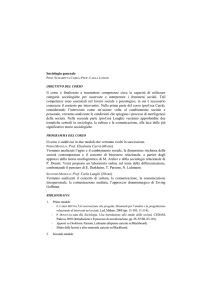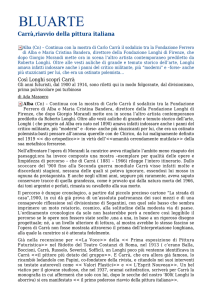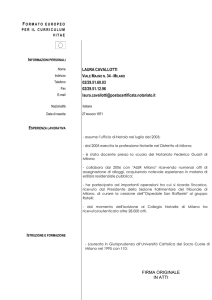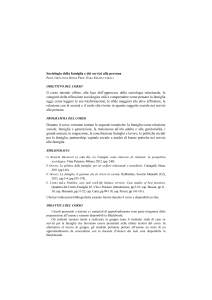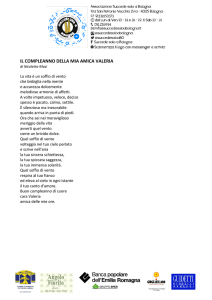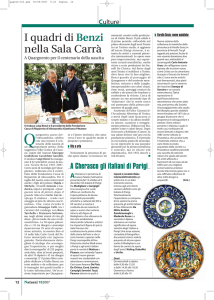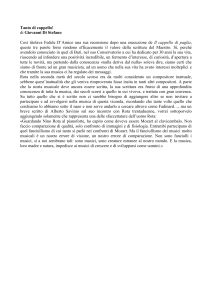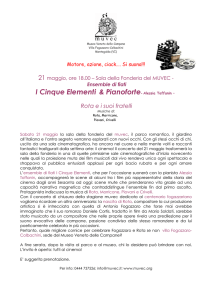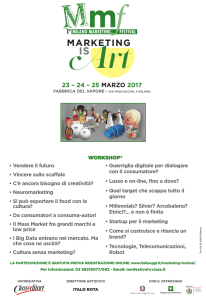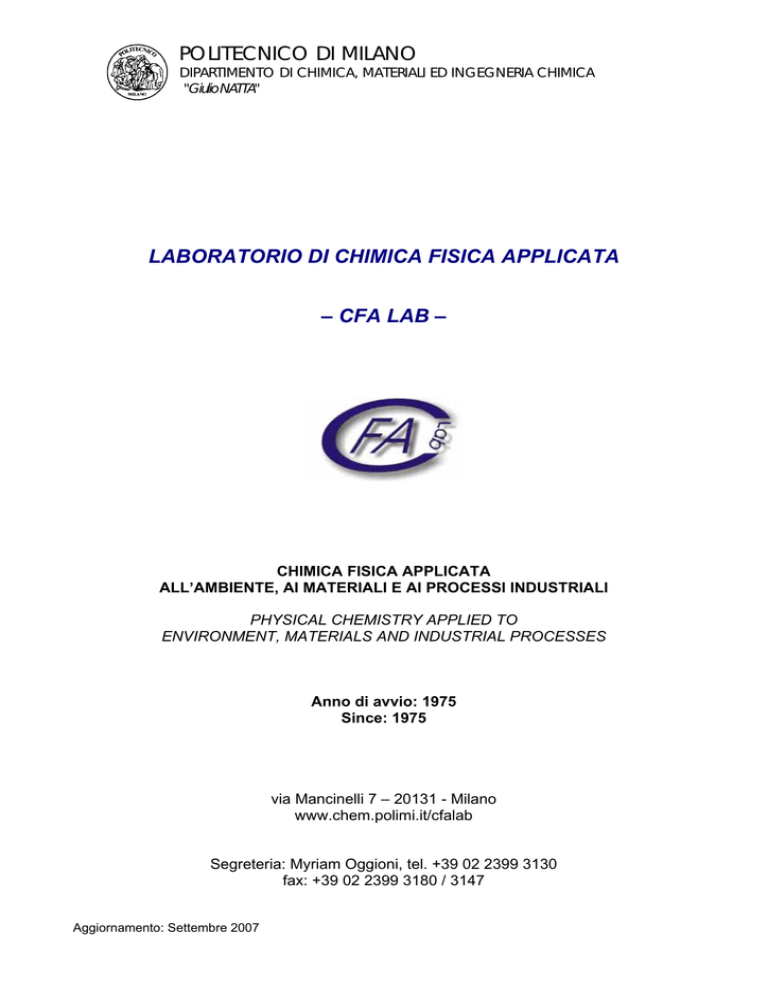
POLITECNICO DI MILANO
DIPARTIMENTO DI CHIMICA, MATERIALI ED INGEGNERIA CHIMICA
" Giulio NATTA"
LABORATORIO DI CHIMICA FISICA APPLICATA
– CFA LAB –
CHIMICA FISICA APPLICATA
ALL’AMBIENTE, AI MATERIALI E AI PROCESSI INDUSTRIALI
PHYSICAL CHEMISTRY APPLIED TO
ENVIRONMENT, MATERIALS AND INDUSTRIAL PROCESSES
Anno di avvio: 1975
Since: 1975
via Mancinelli 7 – 20131 - Milano
www.chem.polimi.it/cfalab
Segreteria: Myriam Oggioni, tel. +39 02 2399 3130
fax: +39 02 2399 3180 / 3147
Aggiornamento: Settembre 2007
POLIMI CMIC CFA LAB
PERSONALE STRUTTURATO / PEOPLE
Sergio Carrà
Carlo Cavallotti
Marco Derudi
℡ 3147
Davino Gelosa
℡ 3176
Simone Gelosa
℡ 3109
Maurizio Masi
℡ 3132
Massimo Morbidelli
℡ 3175
Davide Moscatelli
℡ 3131
Giuseppe Nano
℡ 3141
Myriam Oggioni
℡ 3135
Renato Rota
℡ 3134
Andrea Sliepcevich
℡ 3130
Giuseppe Storti
℡ 3154
℡ 3192
℡ 3163
2
POLIMI CMIC CFA LAB
DOTTORANDI / PhD Students (2007):
Davide Moiani, Maurizio Rondanini, Aurelie Sully, Alessandro Villani, Alessandro Barbato, Sarah Fadda,
Alessandro Fiorucci, Silvia Mancarella, Francesca Migliorini, Laura Zamolo.
BORSISTI / FELLOWSHIP STUDENTS (2007):
Valentina Busini, Simona Caragliano, Giuseppe Perale
email: [email protected] - tel. +39 02 2399 xxxx
COOPERAZIONI NAZIONALI / DOMESTIC COOPERATIONS
Enea, Roma
Enel Produzione Ricerca, Pisa
E.T.C., Catania
Ferrari, Maranello (MO)
IBCHEM, Brindisi
LPE, Bollate (MI)
Mapei, Milano
Mythen
Memc , Novara
MG Mossi Ghisolfi, Tortona (Al)
Oxon, Pavia
Pirelli, Milano
Riello, Legnago (VR)
SNIA Caffaro, Torviscosa (UD)
Solvay Solexis, Bollate (MI)
Eurotecnica (MI)
COOPERAZIONI INTERNAZIONALI / INTERNATIONAL COOPERATIONS
ETH Eidgenössische Technische Hochschule Zürich, (CH)
Mitsubishi Chemical Corporation, Japan
MIT – Massachusetts Institute of Technology, Cambridge, MA, USA;
University of California, Berkeley, California, USA
University of Notre Dame, IN, USA.
FINANZIAMENTI / GOVERNMENT LIKE GRANTS
1998
1999
2000
2001
2002
2003
2004
2005
2006
keuro
307
252
131
76
337
421
250
200
225
CNR, MIUR, Min. Lavoro, UE,
CNR, MIUR, UE
CNR, UE
CNR, MIUR
ACNA, ASI, CNR, MIUR, UE
ACNA, ASI, CNR, ISPSEL, MIUR, UE
UE, ACNA, ASPEL, ASI
UE, ACNA, IRER, IPSEL
UE, AIMS, MIUR
3
POLIMI CMIC CFA LAB
CONTRATTI CONTO TERZI / CONSULTANCY
1998
1999
2000
2001
2002
2003
keuro
68
53
162
227
231
293
2004
260
2005
170
2006
250
Carbochimica, Sisas, Temav
Sisas, Temav
Enel, Ferrari, Lpe, Memc, Novaceta
Enel, Eurotecnica, Ferrari, Lpe, Mapei, Memc, Sapio
Caffaro, Enel, Eurotecnica, Lpe, Mapei, Memc, Pirelli, Sapio
Eurotecnica, ETC, IBChem, LPE, Mapei, MG, Oxon, Riello,
SNIA
Eurotecnica, Mapei, Syndial, Oxon, ETC, Gale, Novara
Technology, ENEL, Perkin-Elmer, Mitsubishi, Pirelli
ENEL, Snam, 3Vsigma, Gale, Dow, Novara Technology, ETC,
Tognana, Oxon, Pirelli
Eurotecnica, Mythen, Enel, Eni tecnologie, Lumen
ILLUSTRAZIONE DELL’ATTIVITÀ:
Sintesi:
Applicazione della chimica fisica all'analisi dei processi industriali chimici, alla sintesi dei materiali,
allo studio dei processi ambientali e alla sicurezza industriale.
Parole chiave:
Chimica quantistica, termodinamica dei sistemi a più fasi, cinetica dei sistemi reagenti complessi,
processi di trasporto, sicurezza, ambiente, fluidodinamica computazionale, materiali avanzati.
Settori applicativi:
Processi industriali, materiali polimerici e materiali inorganici per tecnologie avanzate,
nanotecnologie, processi di combustione e problemi concernenti l'abbattimento degli inquinanti,
sicurezza nell’industria di processo.
Attività di ricerca:
L'approccio seguito dal gruppo di ricerca è volto allo studio di alcuni processi industriali relativi alla
sintesi di materiali polimerici e inorganici e dei processi di combustione. Inoltre vengono affrontati
problemi relativi all'eliminazione degli inquinanti prodotti sia dai processi chimici che da quelli di
combustione, nonché quelli relativi alla sicurezza in ambito industriale. Tutto ciò fruendo delle
conoscenze note, o da sviluppare, sui loro aspetti chimico fisici.
In questo quadro le indagini vengono condotte sia dal punto di vista sperimentale che teorico e
modellistico, con un ampio respiro che parte dalla descrizione dei processi elementari che
avvengono su scala atomica procedendo verso i processi che hanno luogo su scala macroscopica.
Un aspetto qualificante concerne l'ampio impiego della chimica fisica molecolare e della chimica
quantistica nell'analisi dei complessi sistemi di reazione che intervengono nei processi menzionati.
Ciò sia per quanto riguarda gli eventi che hanno luogo in fase gassosa che per quanto concerne le
trasformazioni che si svolgono sulle superfici, con l'intento di individuare i criteri che condizionano
la natura dei materiali così ottenuti.
Un importante obiettivo riguarda la formulazione di modelli di simulazione nei quali le menzionate
teorie microscopiche si integrano con le analisi di carattere fluido dinamico dei processi di
trasporto di materia e calore e quelli di mescolamento, in modo tale da poter offrire degli strumenti
4
POLIMI CMIC CFA LAB
efficaci per la progettazione di unità di sintesi innovative per quanto riguarda sia la loro
configurazione che la loro efficienza.
Fra gli esempi di problemi affrontati si possono menzionare i seguenti.
1) l'individuazione dei criteri operativi e delle metodologie che consentono la preparazione di
materiali polimerici con caratteristiche ben definite anche per un loro impiego in settori che
riguardano la chimica secondaria quali ad esempio quello degli adesivi.
2) la progettazione di reattori di sintesi di materiali inorganici con ben definite caratteristiche
strutturali mediante deposizione chimica da fase vapore o da plasma. In particolare l'attenzione
è volta all'individuazione dei criteri operativi in virtù dei quali si può condizionare la formazione
di monocristalli, di policristalli o di materiali amorfi.
3) lo sviluppo attraverso lo studio dettagliato delle reazioni di combustione di bruciatori innovativi
a basso impatto ambientale, quali quelli senza fiamma. Lo studio, condotto sia
sperimentalmente sia fruendo di modelli di simulazione, tende a definire le condizioni operative
ottimali da un punto di vista energetico ed ambientale.
4) Lo sviluppo di processi chimici in reattori innovativi (reattori multifase) e in settori industriali
differenti dall’industria chimica tradizionale (industria elettronica, industria meccanica trasporti).
HIGHLIGHT OF ACTIVITIES:
Statement:
Application of physical chemistry fundamentals to analyze industrial processes of chemical nature,
the materials synthesis (inorganic and polymers) and their environmental and safety aspects.
Keywords:
Quantum Chemistry, thermodynamics of multiphase systems, chemical kinetics of reacting
systems, transport processes, process safety, environmental processing, reactive computational
fluid dynamics, advanced materials.
Applications:
Industrial processes with chemical implications, polymers and inorganic materials for advanced
technologies, nanotechnology, combustion processes and problems related to pollutants capture,
safety in industrial processes.
Research:
The development of competitive technologies is nowadays based on the detailed understanding of
the relevant physico-chemical processes involved in. The approach followed by our group involves
the application of the physical chemistry principles to investigate and to elucidate these processes
both experimentally and theoretically through suitable mathematical models. This methodology
provides the possibility of scaling the development of new technologies at all required scales, from
the molecular one to that relevant for the industrial production. A qualifying aspect concerns the
application of molecular physical chemistry and of quantum chemistry to the analysis of the
complex reacting systems occurring in the mentioned processes. That approach is valid for the
events and transformations occurring either in gas phase or on surfaces, whose final aim is the
highlight of the governing criteria of the examined process.
The horizontality of this approach makes it suitable for different areas of industrial activities,
including the processes typical of the chemical industry, the design and synthesis of materials and
the problems related to the environmental sustainability (for instance, industrial safety and pollution
control).
Another important goal is the formulation of mechanistic models where the above-mentioned
microscopic theories are embedded in fluid dynamic analysis accounting for mass, momentum and
5
POLIMI CMIC CFA LAB
energy transport phenomena. Accordingly, effective tools are then available for the design of
innovative units or for the efficiency increase of the existing ones.
Among the examples we can mention:
1) Selection of operative criteria and methods that allow the production of polymers with designed
properties for the applications of interest, like for applications in the adhesives compartment.
2) Design of functional inorganic materials through chemical vapor deposition reactors (thermally
or plasma activated). Here, the attention is focused to the selection of operative criteria
controlling the formation of amorphous, single- or poly-crystalline film structures.
3) Design of innovative burners with low environmental impact, like the flameless ones, through
the detailed study of combustion reactions. Both experimental pilot plants and models are used
together to select optimal operational parameters from the energetic and the environmental
point of views.
4) Development of chemical processes in innovative reactors (multiphase reactors) and in
industrial compartments often different than the traditional chemical industry (electronics and
mechanics – transport industries).
The pictures shown here provide an illustration of projects typical of our activities.
Simulazione tridimensionale con codici di
fluidodinamica computazionale di un reattore di
crescita di film di silicio. La figura mostra i campi
di moto in diverse posizioni.
Computed bonding orbital of a metal-organic
copper compound through quantum chemistry.
Orbitali di legame calcolati con codici di chimica
computazionale in un complesso metallorganico
Three-dimensional CFD simulation of a chemical
del rame.
reactor for silicon growth. Figure shows the flow
fields in different locations.
6
POLIMI CMIC CFA LAB
Bruciatore senza fiamma a basso impatto
ambientale in scala di laboratorio
Laboratory-scale flameless burner with low
environmental impact
Fully automated laboratory-scale plant for
polymer production processes.
Impianto in scala di laboratorio completamente
automatizzato per processi di polimerizzazione
Experimental and simulated flow field during silicon wafers wet cleaning processes
Campo di moto sperimentale e calcolato durante un processo di pulizia chimica ad umido di wafer
di silicio
SiCl 3
SiCl4 SiHCl3
SiCl 2
SiHCl
SiH 2Cl 2 H 2 HCl
+ Cl*
SiCl *
Epitaxial film
H * Cl *
Si(s)
Esempio di schema cinetico complesso
coinvolgente reazioni chimiche elementari
(deposizione di silicio da clorosilani): costanti
cinetiche stimate per via quantomeccanica.
Example of a complex mechanism involving
Silicon surface during epitaxial growth simulated
through Kinetic Monte Carlo Method (KMCM)
Simulazione della superficie di silicio durante la
crescita epitassiale effettuata tramite Metodo
Monte Carlo Cinetico.
7
POLIMI CMIC CFA LAB
elementary chemical reactions (silicon
deposition from chlorosilanes): rate constants
estimated through quantum mechanics
calculations.
speed
hold up
O2 liq
CHX liq
Adipic Ac
Reattore gas liquido tipo air lift e simulazione del campo di moto,gas hold up, e concentrazione dei
principali reagenti (ossidazione cicloesano ad acido adipico)
Air-lift gas-liquid reactor and simulation of flow field, gas hold up and concentrations of main
reactants (cyclohexane oxidation to adipic acid)
SELEZIONE DELLE PUBBLICAZIONI RECENTI / SELECTION OF RECENT PUBLICATIONS
(2001 – 2006)
EDITORI DI LIBRI / BOOKS EDITOR
-
S. Carrà and C. Paorici, Crystal Growth: from basic to appplied. Collana Fondazione G. Donegani, Accademia
Nazionale dei Lincei, Roma IT, pp. 1-190, (2003)
-
S. Carrà, The World of Chemistry. Encyclopedia of Life Support Systems (EOLSS), developed under the auspices of
the UNESCO, Eolss Publishers, Oxford, UK, [http://www.eolss.net] (2002).
G. B. Bartolucci, A. Foschini, G. Nano, Atti del 20° Congresso Nazionale dell'Associazione Italiana degli Igienisti
Industriali, PI-ME Editrice, Pavia, ISBN: 88-7963-137-3 (2002).
-
-
D. Crippa, M. Masi, D. L. Rode, Silicon Epitaxy. Semiconductor and Semimetals 72, Academic Press, San Diego
CA, ISBN: 0-12-752181-x, pp. 1-491 (2001).
G.B. Bartolucci, M. Casciani, D. Cavallo and G. Nano, Atti 19° Congresso nazionale dell'Associazione Italiana degli
igienisti Industriali, ISBN 88-7963-123-3 (2001).
RIVISTE CLASSIFICATE ISI / ISI CLASSIFIED JOURNALS
-
-
C. Pelosi, G. Attolini, M. Bosi, D. Moscatelli, A. Generoni, M. Masi, “A new MOVPE reactor for heteroepitaxial GaAs
deposition on large-scale Ge substrates”, J. Crystal Growth 287, 2006.
Carlo Cavallotti, Marco Di Stanislao, Davide Moscatelli and Alessandro Veneroni, “Materials Computation Towards
Technological Impact: The Multiscale Approach to Thin Films Deposition, Electrochimica Acta, 50, pagg.4566-4575,
2005.
Carlo Cavallotti, Davide Moscatelli, Alessandro Veneroni, “A Multiscale study of the epitaxial CVD of Si from
Chlorosilanes”, International Series of Numerical Mahematics, vol. 149, 29-39, 2005, Birkhäuser Verlag
Basel/Switzerland.
8
POLIMI CMIC CFA LAB
-
-
-
Davide Moscatelli, Pierpaolo Caccioppoli and Carlo Cavallotti, “Ab Initio study of the gas phase nucleation
mechanism of GaN”, Appl. Phys. Lett. 86, (2005).
A. Veneroni, D. Moscatelli, M. Masi, “Modeling of large scale horizontal reactor for silicon epitaxy”, Journal of Crystal
Growth, 275, pp. e289-e293 (2005).
A. Veneroni, F. Omarini, D. Moscatelli, M. Masi, S. Leone, M. Muaceri, G. Pistone, G. Abbondanza, “Modeling of
epitaxial silicon carbide deposition”, Journal of Crystal Growth, 275, pp. e295-e300 (2005).
A. Veneroni, F. Omarini, M. Masi, “Silicon carbide growth mechanism from SiH4, SiHCl3 and nC3H8”, Crystal
Research Technology, 40, pp. 967-971 (2005).
F. Maestri, R. Rota, “Thermally safe operation of liquid–liquid semibatch reactors. Part I: Single kinetically controlled
reactions with arbitrary reaction order”, Chemical Engineering Science, 60, 3309-3322 (2005). ISSN: 0009-2509
Carlo Cavallotti, Davide Moscatelli, and Sergio Carrà, “Theoretical investigation of the low and high temperature
MOVPE of Zinc Selenide”, J. Phys. Chem. A, Vol. 108(7), Pagg. 1214-1223, 2004.
M. Rondanini, C. Cavallotti, D. Moscatelli, M. Masi, S. Carrà, “A combined fluid dynamics and 3D kinetic monte carlo
investigation of the selective deposition of GaAs and InP”, Journal of Crystal Growth, 272, pp. 52-58 (2004).
C. Cavallotti, D. Moscatelli, M. Masi, S. Carrà, “Accelerated decomposition of gas phase metal organic molecules
determined by radical reactions”, Journal of Crystal Growth, 266, pp. 363-370 (2004).
S. Fascella, C. Cavallotti, R. Rota, S. Carra`, “Quantum chemistry investigation of key Reactions Involved in the
Formation of Naphthalene and Indene”, J. of Phys. Chem. A, 108, 3829-3843 (2004). ISSN: 1089-5639
A. Lunghi, L. Gigante, P. Cardillo, V. Stefanoni, G. Pulga, R. Rota, “Hazard assessment of substances produced
from the accidental heating of chemical compounds”, Journal of Hazardous Materials, A116, 11–21 (2004), ISSN:
0304-3894
V. Bertani, C. Cavallotti, M. Masi and S. Carrà, “A theoretical analysis of the molecular events involved in
hydrocarbons reactivity on palladium clusters", Journal of Molecular Catalysis A, 204-205, pp. 771-778 (2003).
A. Borroni, G. Nano, R. Rota, "Pollution prevention in EAF industries", Chemical Engineering Transactions, 3, pp.
847-852 (2003).
A. Cavigiolo, M.A., Galbiati, A. Effuggi, D. Gelosa, R. Rota, "Mild Combustion in a Laboratory-Scale Apparatus",
Combustion Science and Techology, 175, pp. 1347-1367 (2003).
A. Cavigiolo, A. Effuggi, M. Galbiati, D. Gelosa, R. Rota, "A Laboratory-Scale Burner for Mild Combustion", Chemical
Engineering Transactions, 3, pp. 231-236 (2003).
M. Derudi, M. Suardi, D. Gelosa, R. Rota, "Experimental study of flue gas desulfurization: sorbent reactivation and
reaction paths", Chemical Engineering Transactions, 3, pp. 805-810 (2003).
D. Gelosa, M. Ramaioli, G. Valente and M. Morbidelli, "Chromatographic Reactors: Esterification of Glycerol with
Acetic Acid Using Acidic Polymeric Resisns", Industrial Engineering Chemistry Research, 42, pp. 6536-6544 (2003)
L. Gigante, A. Lunghi, S. Martinelli, P. Cardillo, L. Picello, R. Bortolaso, M. Galvagni, R. Rota, "Calorimetric approach
and simulation for scale-up of a Friedel-Crafts reaction", Organic Process Research & Development, 7, pp. 10791082 (2003).
D. Moscatelli, C. Cavallotti, M. Masi and S. Carrà, "A quantum chemistry investigation of the gas phase and surface
chemistry of the MOVCD of ZnSe", Journal of Crystal Growth, 248, pp. 31-36 (2003).
G. Nano, A. Borroni, R. Rota, "Combined slurry and solid–phase bioremediation of diesel contaminated soils",
Journal of Hazardous Materials, B100, pp. 79-94 (2003).
G.Nano, A. Borroni, A. Jacomelli and R. Rota, "Bioremediation of polluted soils with slurry and solid-phase
bioreactors", Chemical Engineering Transactions, 3, pp. 853-858 (2003).
R. Rota and E.F. Zanoelo, "Prediction of Auto-Ignition Hazard of Industrial Mixtures Using Detailed Kinetic
Modeling", Industrial and Engineering Chemistry Research, 42, pp. 2940-2945 (2003).
R. Rota and E.F. Zanoelo, "Influence of oxygenated additives on the NOxOUT process efficency", Fuel, 82, pp. 765770 (2003).
L. Silvestri, H.R. Brown, St. Carrà and S. Carrà, "Chain entanglements and fracture energy in interfaces between
immiscible polymers", Journal of Chemical Physics, 119, pp. 8140-8149 (2003).
S. Carrà, "Nanotecnologie - Fascino e speranze per un rilancio della chimica", La Chimica e l'Industria (2002).
S. Carrà, "La Scienza degli oggetti" Iter V, n. 16-17 pag. 45-49 Istituto della Enciclopedia Italiana ISSN: iter 11266600 (2002).
C. Cavallotti, R. Rota and S. Carrà, "Quantum chemistry computation of rate constants for reaction involved in the
first aromatic ring formation", Journal of Physical Chemistry A, 106, pp. 7769-778 (2002).
M. Di Stanislao, G. Valente, S. Fascella, C. Spampinato, M. Masi and S. Carrà "Multi-model hierarchy approach to
simulat barrel reactors for epitaxial silicon deposition", Journal de Physique IV France, Pr 4, pp. 121-128 (2002).
M. Polli, M. Di Stanislao, R. Bagatin, E. Abu Bakr, M. Masi, "Bubble size distribution in the sparger region of bubble
columns", Chemical Engineering Science, 57, pp. 197-205 (2002).
R. Rota, G. Ruggeri, M. Morbidelli and S. Ditali, "Influence of calorimetric approximations on the design of
emergency relief system", Journal of Loss Prevention in the Process Industries, 15, pp. 49-61 (2002).
R. Rota, D. Antos, E.F. Zanoelo and M. Morbidelli, "Experimental and modeling analysis of the NOxOUT process",
Chemical Engineering Science, 57, pp. 27-38 (2002).
M. Masi, "Multiscale approach to material synthesis by gas phase deposition", Journal de Physique IV France,
11Pr3, pp. 117-128 (2001).
R. Rota, "Chemical kinetic analysis of the thermal DeNOx process at high concentration of reactants", Chemical
Engineering and Technology, 24, pp. 539-541 (2001).
R. Rota, G. Nano, L. Canossa, "Design Guidelines for Push-Pull Ventilation Systems Through Computational Fluid
Dynamics Modeling", AIHAJ , 62, pp. 141-148 (2001).
9
POLIMI CMIC CFA LAB
-
R. Rota, L. Canossa and G. Nano, "Ventilation Design of Industrial Premises Through CFD Modelling", The
Canadian Journal of Chemical Engineering, 79, pp. 80-86 (2001).
R. Rota, D. Antos, E.F. Zanoelo and S. Carrà, "Experimental Study and Kinetic Modelling of Nitric Oxide Reduction
with Ammonia", Combustion Science and Technology, 163, pp. 25-47 (2001).
R. Rota, S. Frattini, S. Astori, R. Paludetto, "Emissions from fixed-roof storage tanks: modeling and experiments",
Industrial and Engineering Chemical Research, 40, pp. 5847-5857 (2001).
G. Valente, C. Cavallotti, M. Masi and S. Carrà, "Reduced order model for the CVD of epitaxial silicon from silane
and chlorosilanes", Journal of Crystal Growth, pp. 247-257 (2001).
CONTRIBUTI SU LIBRI DI RILEVANZA E ECCELLENZA SCIENTIFICA / ARTICLES ON INTERNATIONAL BOOKS
OF RECOGNIZED EXCELLENCE
-
-
-
-
-
-
-
-
-
-
-
M. Masi, “Crescita cristallina da fase vapore”, Enciclopedia del Novecento, supplemento III, volume A-G, pp. 277287, Istituto dell’Enciclopedia Italiana, Roma (2004).
E. Alleva, S. Carrà, G. Corbellini, G. Parisi, La grande scienza, Storia della Scienza, IX volume, Istituto
dell'Enciclopedia Italiana Treccani, pp. 131-143 (2003).
S.Carrà, "Dinamica dei sistemi reagenti complessi", Storia della Scienza, IX volume, Istituto dell'Enciclopedia
Italiana Treccani, pp. 375-384 (2003).
S.Carrà, "Energia", Storia della Scienza, IX volume, Istituto dell'Enciclopedia Italiana Treccani, pp. 405-415 (2003).
S.Carrà, Prefaction to "Evoluzione senza selezione. Autoevoluzione di Forma e Funzione" di A. Lima-de-Faria, Nova
Scripta Edizioni Genova, pp. xix-xxiii (2003).
S. Carrà and C. Paorici, foreword to “Crystal Growth: from basic to applied”, Collana Fondazione G. Donegani,
Accademia Nazionale dei Lincei, Roma, pp.. 7-12 (2003).
C. Cavallotti, “CVD: multiscale study of the selective deposition of AlGaAs in the presence of HCl”, Collana
Fondazione G. Donegani, Accademia Nazionale dei Lincei, Roma, pp.. 97-120 (2003).
M. Di Stanislao, G. Valente, S. Fascella, M. Masi, S. Carra' and J. Fei, S. Yarlagadda, "Simulation of epitaxial silicon
deposition and dopant incorportation in a industrial barrel reactor", Chemical Vepor Deposition XVI and EUROCVD
14, Edited by M. Allendorf, F. Maury, F. Teyssandier, The Electrochemical Society, Pennington NJ, vol 1, pp. 226235 (2003).
M. Masi, M. Di Stanislao, A. Veneroni, C. Cavallotti, S. Carrà, “CVD: from process to properties”, Collana
Fondazione G. Donegani, Accademia Nazionale dei Lincei, Roma, pp. 65-96 (2003).
D. Moscatelli, C. Cavallotti, M. Masi and S. Carrà, "Surface and Gas Phase Chemistry of the MOCVD of ZnSe",
Chemical Vepor Deposition XVI and EUROCVD 14, Edited by M. Allendorf, F. Maury, F. Teyssandier, The
Electrochemical Society, Pennington NJ, vol 1, pp. 15-21 (2003).
S.Carrà, "Statistical Approach to Thermodynamics" in The World of Chemistry, edited by S. Carrà in Encyclopedia
of Life Support Systems (EOLSS), Developed under the auspices of the UNESCO, Eolss Publishers, Oxford,UK,
[http://www.eolss.net] (2002).
S.Carrà, "Dynamic behaviour of complex reacting systems: role of non-linearity" in The World of Chemistry, edited
by S. Carrà in Encyclopedia of Life Support Systems (EOLSS), Developed under the auspices of the UNESCO,
Eolss Publishers, Oxford,UK, [http://www.eolss.net] (2002).
S.Carrà and M. Masi, "History and Fundamentals of Chemistry" in The World of Chemistry edited by S. Carrà in
Encyclopedia of Life Support Systems (EOLSS), Developed under the auspices of the UNESCO, Eolss Publishers,
Oxford,UK, [http://www.eolss.net] (2002).
C. Cavallotti, "Synthesis of Nanophases", in The World of Chemistry, edited by S. Carrà in Encyclopedia of Life
Support Systems (EOLSS), Developed under the auspices of the UNESCO, Eolss Publishers, Oxford,UK,
[http://www.eolss.net] (2002).
D.Gelosa and A. Sliepcevich, "Chemical laboratory techniques", in The World of Chemistry, edited by S. Carrà in
Encyclopedia of Life Support Systems (EOLSS), Developed under the auspices of the UNESCO, Eolss Publishers,
Oxford,UK, [http://www.eolss.net] (2002).
M. Masi, "Thermodynamic systems and state function", in The World of Chemistry, edited by S. Carrà in
Encyclopedia of Life Support Systems (EOLSS), Developed under the auspices of the UNESCO, Eolss Publishers,
Oxford,UK, [http://www.eolss.net] (2002).
M. Masi, "Energy balance of reacting systems", in The World of Chemistry, edited by S. Carrà in Encyclopedia of
Life Support Systems (EOLSS), Developed under the auspices of the UNESCO, Eolss Publishers, Oxford,UK,
[http://www.eolss.net] (2002).
R. Rota, "Microkinetics versus macrokinetics: role of transport phenomena on reaction rate", in The World of
Chemistry, edited by S. Carrà in Encyclopedia of Life Support Systems (EOLSS), Developed under the auspices of
the UNESCO, Eolss Publishers, Oxford,UK, [http://www.eolss.net] (2002).
R. Rota, "Equilibrium in multiphase reacting systems", in The World of Chemistry, edited by S. Carrà in
Encyclopedia of Life Support Systems (EOLSS), Developed under the auspices of the UNESCO, Eolss Publishers,
Oxford,UK, [http://www.eolss.net] (2002).
10
POLIMI CMIC CFA LAB
-
-
-
-
-
-
-
-
A. Sliepcevich and D. Gelosa, "Gas and liquid chromatography", in The World of Chemistry, edited by S. Carrà in
Encyclopedia of Life Support Systems (EOLSS), Developed under the auspices of the UNESCO, Eolss Publishers,
Oxford,UK, [http://www.eolss.net] (2002).
M. Masi, C. Cavallotti, G. Valente, M. Di Stanislao, "Multi-scale and multi-hierarchy modeling in electronic materials
processing", in Computational Tecnologies for Fluid/Thermal/Structural/Chemical Systems with Industrial
Applications, Editors C.R. Kleijn and S. Kawano, The American Society of Mechanical Engineers, ASME PVP
Symposium Proceedings, 448-1, pp. 89-100 (2002).
St. Carrà, D. Pinoci and S. Carrà, A model for the Drying Process During Film Formation in Waterborne Acrylic
Coatings", Wiley_VCH Verlag Weinheim, Macromolecular Symposia, 187, pp. 585-596 (2002).
V. Bertani, C. Cavallotti, M. Masi, S. Carrà, "A Kinetic Study of Hydrocarbon Reactivity on Palladiuum Catalysis
through a DFT Approach", in Advances in Materials Theory and Modeling-Bridging Over Multiple-Length and Time
Scales, Editors V. Bulatov, L. Colombo, F. Cleri, L.J. Lewis, N. Mousseau, Materials Research Society Symposium
Proceedings, 677, pp. AA8.6.1-AA8.6.6, (2001).
M. Masi and S. Carrà, "Silicon Vapor Epitaxy: Reactor Design and Process Simulations", in Encyclopedia of
Materials: Science and Technology, Elsevier NL, pp. 8587-8593 (2001).
Sergio Carrà and Carlo Cavallotti, "I nuovi materiali", Le Grandi Domande della Scienza e della Tecnica (multimedia)
www.archimedes.sns.it/grandidomande/index.php3 (2001).
St. Carrà, L. Malcovati, A. Sliepcevich, G. Storti and S. Carrà, "Stabilization Mechanisms in Vinyl Acetate Emulsion
Polymerization Stabilized by Poly(vinyl alcohol)”, in Polymer Colloids - Science and Technology of Latex Systems,
Editors E.S. Daniels, E. David Sudol, M.S. El-Asser, American Chemical Society, Washington, DC, ACS
Symposium Series, 801, pp. 198-220 (2001).
M. Nemirovskaya, C. Cavallotti, Klavs F. Jensen, “Computational investigation of selective MOVPE of AlxGa1-xAs in
presence of HCl”, in Current Issues in Heteroepitaxial Growth, Stress Relaxation and Self Assembly, Editors E.
Stach, E. Chason, R. Hull and S. Badser, Materials Research Society, Warrendale, PA, Materials Research Society
Symposium Proceedings, 696, (2001).
R. Rota, M. Morbidelli, S. Ditali, "Influence of kinetic model approximation in batch reactors safety analysis", in Loss
Prevention and Safety Promotion in the Process Industries, Editors H.J. Pasman, O. Fredholm, A. Jacobson,
Elsevier Oxford UK, I, pp. 631-642 (2001).
M. Masi, C. Cavallotti, S. Carrà, “Gas phase and surface kinetics of silicon chemical vapor deposition from silane
and chlorosilanes”, Silicon-Based Materials and Devices, H. S. Nalwa (editor), Academic Press, San Diego CA, vol.
1, chapter 4, pp. 155-186 (2001).
M. Masi, S. Carrà, “Reactor design and process simulations for silicon vapor epitaxy”, Encyclopedia of Materials:
Science and Technology, Elsevier Science, Oxford UK, Chapter 6.6.36, pp. 8687-8593 (2001).
M. Masi and S. Kommu, “Epitaxial Reactor Modeling”, in Silicon Epitaxy, Eds. D. Crippa, M. Masi, D.L. Rode,
Academic Press, San Diego CA, Chapter 6, pp. 185-224 (2001).
C. Cavallotti and M. Masi, "Epitaxial Growth Theory: Vapor Phase and Surface Chemistry", in Silicon Epitaxy, Eds.
D. Crippa, M. Masi, D.L. Rode, Academic Press, San Diego CA, Chapter 2, pp. 51-88 (2001).
11


